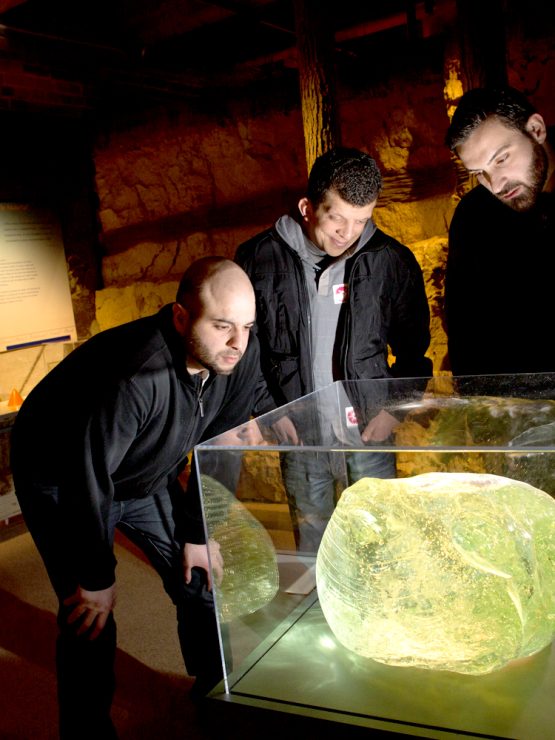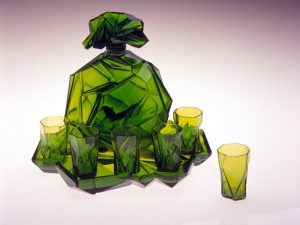
Glass: Shattering Notions
Long before being known as the Steel City, Pittsburgh was America’s Glass City. The Glass exhibition showcases the beauty, science, utility and technology of Western Pennsylvania glass over the past 200 years.
While the story of glass in America began at Jamestown in 1608, almost 200 years passed before skilled glassworkers crossed the Allegheny Mountains and began production in Western Pennsylvania. Since 1797, when the region’s first two glasshouses opened, the conical furnace stacks of glass factories have been a defining feature of the region’s skyline. Scores of glasshouses followed, producing rivers of glass for an abundant variety of uses around the nation and eventually around the world. By the Civil War, the Pittsburgh region reigned as the center of the nation’s glass industry.
A generation later, Pittsburgh glass could be found everywhere: as tile for the walls of New York’s great transportation tunnels, in the searchlights on the Panama Canal, as insulators for endless miles of wire; in “Liberty lens” headlights for Ford automobiles, in beer halls and in bars. Yet this region also produced glass fine enough for use on the White House tables of five U.S. presidents and in embassies around the world. Bottles by the boxcar load and singular presentation pieces, Pittsburgh factories made it all. Gas and electric streetlights, lamps, light bulbs, and lamp chimneys, our factories lit the world. Lenses and traffic signals brought order and safety to railways, roadways, and runways and plate glass for large windows made department stores a reality, allowing consumers to shop from the sidewalk. Store fronts of Carrera glass, basement windows of glass block, skyscrapers sheathed with reflective glass windows – the uses for glass seemed endless.
The Pittsburgh region became a center for the production of glass, but also for innovations in its manufacture, design, and marketing. Glass: Shattering Notions tells that story, unraveling the complex 200 plus year history of this region’s first industry. With one of the premier regional collections of glass known, the exhibit features more than 500 glass objects, immersive environments, hands-on interactives, and audio and video to help you look at, not through the glass in your life and hopefully see and understand it in a new way.
Exhibit Must-Sees
- Zoo case – Glass birds, fish, animals, and more all are corralled in our zoo case.
- Steamboat salts – Pittsburgh honored its reputation as the Gateway to the West and a center for steamboat building with these delicate pressed steamboat salts.
- Giant piece of glass cullet – A piece of waste glass had to be chipped out of the furnace at L.E. Smith in Mount Pleasant, Pa. after the material failed to melt properly.
- Window glass video – Rare footage shows Belgian blowers making cylinder window glass in Jeannette in 1905. Soon after, drawing machines replaced skilled blowers on the factory floor.
- Fry FOVAL lamp – Made from the same glass the Fry Company of Rochester, Pa. used in their ovenware, this delicate lamp is one of only a few known.
- Pattern glass sugar bowl – Likely made by the McKee Glass Co. of Pittsburgh, this c. 1850 sugar bowl has a piece of pressed glass on each panel of the body and lid and serves as an advertisement for the company’s wares.

More in the Book
A companion book, “Glass: Shattering Notions,” written by History Center’s Anne Madarasz, tells the story of glass on a local and national scale through numerous personal and business histories. Pittsburgh-produced glass has been used in fine tableware for five U.S. presidents, as tiles for the walls of New York City’s great tunnels, and in searchlights at the Panama Canal. “Glass: Shattering Notions” is available in the Museum Shop, or in the History Center’s online shop.